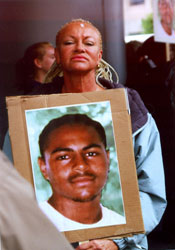THE IDRISS STELLEY FOUNDATION STORY
(PART 2 of 3)
 |
|
by Marlon Crump/PNN “At his funeral, Idriss was eulogized as "Our Shaman" by the Dean of Students of SF Healds College, Mr. Patrick Hutchinson…Idriss counseled many fellow students, among them a single dad [who was] suicidal and said at the funeral mass, that Idriss saved his life. These were just some of Idriss Stelley' success stories," his mother told me, a proud smile on her lips, as we continued our interview on the life and death of her son. We sat at her home in the Bayview Hunters Point in early December. In between sips of freshly brewed coffee, meshá showed me Idriss' diplomas and awards and shared stories from his life. I marveled at Idriss' awards, trophies and accomplishments, including his Second Degree Black Belt Karate diploma and his Post Mortem "Resistance Award" received from POOR Magazine. mesha continued showing me his seemingly endless memorabilia, including his craftsmanship of an unfinished stone sculpture, an Egyptian Sphinx that meshá gave me to keep. Idriss was in the Marble Union and was working on this sphinx on the very day he was killed by the SFPD. "He did not get a chance to finish it….†she explained, her voice sadly trailing off. She then began to tell me about Idriss’ birth. Idriss Scott Stelley was born on August 20th, 1977 at the Alternative Birth Center at the San Francisco General Hospital in a room full of incense, Indian music of Ravi Shankar and cheering friends. Idriss graduated first out of 90 students from Optnet in Advanced Web Design, and was a Spanish tutor at Wallenberg High School, as well as a French and Advanced Math tutor at San Francisco City College and John Adams Community College. With an IQ of 145, Idriss tutored in colleges even before his own graduation from High School through Independent Studies. He also taught ESL to undocumented migrants at the San Francisco Day Labor Program, volunteered on the AIDS Ward 5A, the very place of his birth , and aided in the soup kitchen at Glide Memorial Church. In addition, Idriss also volunteered at Arriba Juntos, a center in the Mission District that provides job readiness workshops, computer labs, and job search skills. He also taught graffiti-airbrush design at a Fillmore center for at-risk Youth, and at 7 years old, was the youngest performing artist of the SF Mime Troupe, in the "Madame Video" play. He also performed in several SF International Franco-American School's Shakespearean productions. Of eclectic taste, Idriss was an avid reader of the mainstream "classics", but favored the works of Malcolm X and his beloved Koran (Idriss converted to Islam at 17). In his apartment the air was often filled with music. From Bach, Bela Bartok, Debussy, Eric Sati, Aranjuez and Misa Criola to Miles Davis, Sidney Bechet, and Thelonius Monk to U2, Tupac, Paris, Sade and Michel Franti, Idriss appreciated many different styles of music. In formal attire and bow tie, he routinely assisted his Godfather, Mr. Henry Watson, who passed away, heartbroken, a year after Idriss' death. Mr. Watson, head usher of the SF Opera House, was a wonderful Black man who introduced Idriss to rich AfriKan American culture as well as his musical and "classical" education. Although I've never met or laid eyes on Idriss, mesha has often told me of how much I remind her of her only child, because we both share a very rare kind of wisdom, and exceptional background. It is always a wonderful feeling to hear mesha say this to me, because I have adopted her as my "Godmother" and feel truly blessed with everything she offers me, especially post-trauma counseling Given everything that I have gone through in the past few years, in my dealing with homelessness, poverty, criminalization, racism, police brutality, and injustice, I feel that meeting Idriss would have restored hope in me about the fate of those struggling in this corrupt society. I believe that our relationship would have shown that unity in non-white communities plagued with poverty, violence, racism and incarceration, is not impossible. And that despite the venomous lies of corporate media and its portrayal of non-white communities and people struggling with poverty, we can unite to make change. "I taught Idriss that it is never too early to commit to social justice," said mesha. As we traded warm smiles, dusk began to blanket the earth outside. I sat my cup of coffee down and we both took a break, before mesha began to share the most difficult part of the interview, and the deepest, darkest moment that forever changed her life and the lives of many others: The Death of Idriss Stelley. To Be Continued in "The Idriss Stelley Foundation Story" Part III. |



